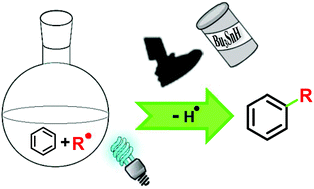A new era for homolytic aromatic substitution: replacing Bu3SnH with efficient light-induced chain reactions†
Abstract
Herein is a pertinent review of recent photochemical homolytic aromatic substitution (HAS) literature. Issues with using the reductant Bu3SnH in an oxidative process where the net loss of a hydrogen atom occurs is discussed. Nowadays more efficient light-induced chain reactions are used resulting in HAS becoming a synthetic mechanism of choice rivaling organometallic, transition-metal and electrophilic aromatic substitution protocols. The review includes aromatic substitution as part of a tandem or cascade reaction, Pschorr reaction, as well as HAS facilitated by ipso-substitution, and Smiles rearrangement. Recently visible-light photoredox catalysis, which is carried out at room temperature has become one of the most important means of aromatic substitution. The main photoredox catalysts used are polypyridine complexes of Ru(II) and Ir(III), although eosin Y is an alternative allowing metal-free HAS. Other radical initiator-free aromatic substitutions have used 9-mesityl-10-methylacridinium ion and N,N-bis(2,6-diisopropylphenyl)perylene-3,4,9,10-bis(dicarboximide) as the photoredox catalyst, UV-light, photoinduced electron-transfer, zwitterionic semiquinone radical anions, and Barton ester intermediates.


 Please wait while we load your content...
Please wait while we load your content...